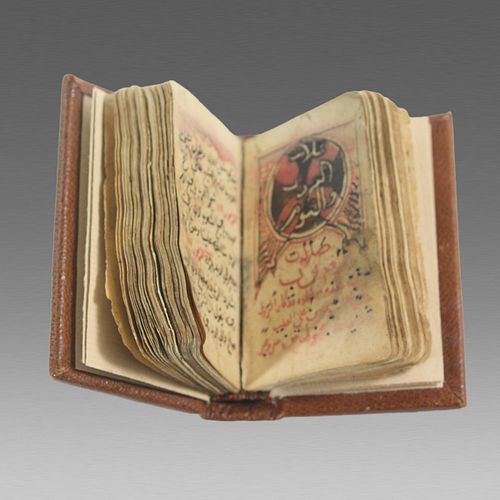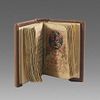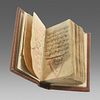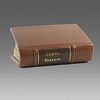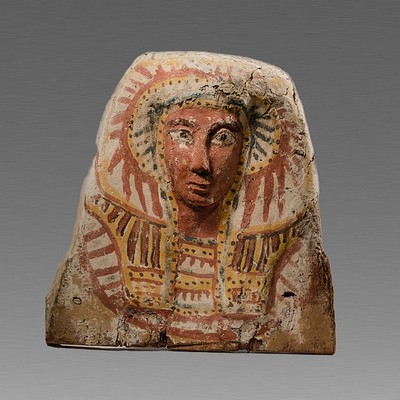Arabic Coptic Miniature Manuscript, Horologion, Signed and Dated
Lot 599
Estimate:
$1,200 - $1,500
Absentee vs Live bid
Two ways to bid:
- Leave a max absentee bid and the platform will bid on your behalf up to your maximum bid during the live auction.
- Bid live during the auction and your bids will be submitted real-time to the auctioneer.
Bid Increments
| Price | Bid Increment |
|---|---|
| $0 | $10 |
| $100 | $25 |
| $500 | $50 |
| $1,000 | $100 |
| $5,000 | $250 |
| $10,000 | $500 |
| $20,000 | $1,000 |
| $50,000 | $2,000 |
| $100,000 | $2,500 |
| $200,000 | $3,000 |
About Auction
By Palmyra Heritage Gallery
Oct 18, 2020
Set Reminder
2020-10-18 11:00:00
2020-10-18 11:00:00
America/New_York
Bidsquare
Bidsquare : Antiquities Ancient Coins Islamic Art Estates
https://www.bidsquare.com/auctions/palmyra-heritage-gallery/antiquities-ancient-coins-islamic-art-estates-5814
Our Sale consist of 2 Estates. One estate from the late Eldert Bontekoe, Pegasi. Ann Harbor Michigan, USA. A prominent Ancient coin and Antiquities dealer. Another estate is from the late Robert Onsted, PA USA. and other smaller collections. Palmyra Heritage Gallery info@palmyraheritagegallery.com
Our Sale consist of 2 Estates. One estate from the late Eldert Bontekoe, Pegasi. Ann Harbor Michigan, USA. A prominent Ancient coin and Antiquities dealer. Another estate is from the late Robert Onsted, PA USA. and other smaller collections. Palmyra Heritage Gallery info@palmyraheritagegallery.com
- Lot Description
Arabic Coptic Miniature Manuscript, Horologion, Signed and Dated. Agpeya (an old Coptic word, meaning ‘Book of Hours’ or Horologion. The Agpeya is primarily used by the Coptic Orthodox Church. It contains prayers for seven different hours to be said throughout the day. The hours are chronologically laid out, each containing a theme corresponding to events in the life of Jesus Christ. Each hour is composed of an introduction which includes the Lord’s Prayer, the Prayer of Thanksgiving, and Psalm 50. It is followed by various Psalms, an excerpt from the Holy Gospel, and Litanies. Lord Have Mercy is then chanted 41 times (representing the 39 lashes Christ received before the crucifixion, plus one for the spear in His side, plus one for the crown of thorns), followed by several other prayers and a conclusion. The Coptic canonical hours are largely monastic, primarily composed of psalm readings. The Coptic Agpeya is equivalent of the Byzantine Horologion. Seven canonical hours exist, corresponding largely to the Byzantine order, with an additional `Prayer of the Veil` which is said by Bishops, Priests, and Monks. The Agpeya is read throughout the day and in many situations. The hours of the day start from sunrise and end at sunset. The morning prayer (Prime), which corresponds to 6 a.m., is said upon waking up in the morning or after the Midnight praise the previous night. The Terce (9 a.m.) and Sext (noon) hours are prayed before each liturgy during the Offering of Incense. The None (3 p.m.) hour is also read during fasting days. Vespers (sunset) and Compline (9 p.m.) are read in the early evening and before bedtime, respectively. and are both read before the Liturgy during the Lent and the fast of Nineveh. The Midnight hour is read just before the Midnight Praise. The Veil hour is reserved for priests, monks, and bishops. The manuscript is beautifully written in naskhi script, 11 lines to a page. Number of folios: 133 (266 pages). Size of manuscript is 4.6 x 7.4 cm (1.75 x 2.75 inches), size of binding is 5.5 x 8.4 cm (2.2 x 3.25 inches). In brown ink, with headings and keywords in red on beige paper. The writing of the manuscript was completed by some calligrapher, who did not mention his name during April 1903 AD. There are four illuminated pages. It is recently bound in full brown textured morocco, with gilt label. Lower part of manuscript is a little affected by dampness, but the text is quite legible except for a few pages and the last page where there are minor losses of a few letters or a few words, otherwise a very good manuscript. Very unusual manuscript. Usually, miniature books and manuscripts are use as talismans to protect the carrier or the place from the evil eye. This is the first miniature Coptic manuscript I have ever handled. It is extremely rare.good condition
Condition
- Shipping Info
-
SHIPPING FEES are the responsibility of the buyer. We can handle most of the shipping of the items we are selling, or we can recommend a local UPS Store to Handle it. All buyers will receive an invoice detailing their purchases, sales tax (if applicable), buyer's premium, and shipping/insurance charges. Items will be shipped only upon receipt of payment in full and will be insured for their full value. For shipments outside of the USA, customs and duties may apply upon entry in to host country, and this fee, if any, is the buyer's responsibility. We will not falsify customs value on international shipments! If you have questions about this, please inquire before bidding.
-
- Payment & Auction Policies
-
Available payment options
-
- Buyer's Premium



 EUR
EUR CAD
CAD AUD
AUD GBP
GBP MXN
MXN HKD
HKD CNY
CNY MYR
MYR SEK
SEK SGD
SGD CHF
CHF THB
THB